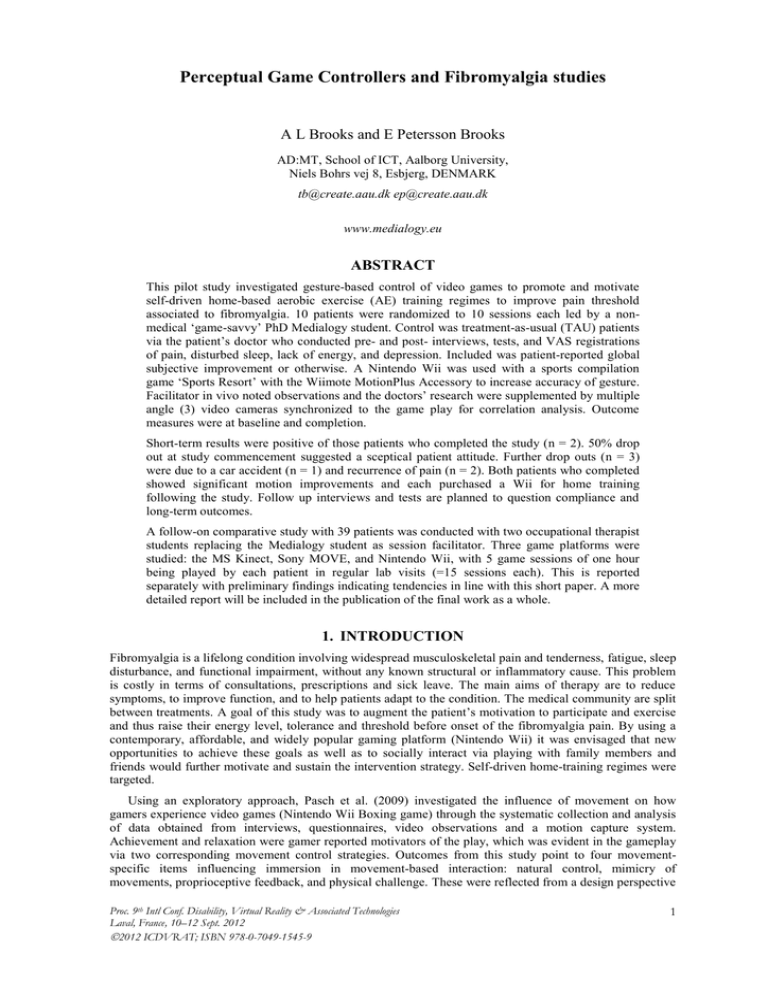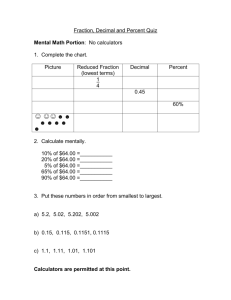081 Fibromyalgia
advertisement

Perceptual Game Controllers and Fibromyalgia studies A L Brooks and E Petersson Brooks AD:MT, School of ICT, Aalborg University, Niels Bohrs vej 8, Esbjerg, DENMARK tb@create.aau.dk ep@create.aau.dk www.medialogy.eu ABSTRACT This pilot study investigated gesture-based control of video games to promote and motivate self-driven home-based aerobic exercise (AE) training regimes to improve pain threshold associated to fibromyalgia. 10 patients were randomized to 10 sessions each led by a nonmedical ‘game-savvy’ PhD Medialogy student. Control was treatment-as-usual (TAU) patients via the patient’s doctor who conducted pre- and post- interviews, tests, and VAS registrations of pain, disturbed sleep, lack of energy, and depression. Included was patient-reported global subjective improvement or otherwise. A Nintendo Wii was used with a sports compilation game ‘Sports Resort’ with the Wiimote MotionPlus Accessory to increase accuracy of gesture. Facilitator in vivo noted observations and the doctors’ research were supplemented by multiple angle (3) video cameras synchronized to the game play for correlation analysis. Outcome measures were at baseline and completion. Short-term results were positive of those patients who completed the study (n = 2). 50% drop out at study commencement suggested a sceptical patient attitude. Further drop outs (n = 3) were due to a car accident (n = 1) and recurrence of pain (n = 2). Both patients who completed showed significant motion improvements and each purchased a Wii for home training following the study. Follow up interviews and tests are planned to question compliance and long-term outcomes. A follow-on comparative study with 39 patients was conducted with two occupational therapist students replacing the Medialogy student as session facilitator. Three game platforms were studied: the MS Kinect, Sony MOVE, and Nintendo Wii, with 5 game sessions of one hour being played by each patient in regular lab visits (=15 sessions each). This is reported separately with preliminary findings indicating tendencies in line with this short paper. A more detailed report will be included in the publication of the final work as a whole. 1. INTRODUCTION Fibromyalgia is a lifelong condition involving widespread musculoskeletal pain and tenderness, fatigue, sleep disturbance, and functional impairment, without any known structural or inflammatory cause. This problem is costly in terms of consultations, prescriptions and sick leave. The main aims of therapy are to reduce symptoms, to improve function, and to help patients adapt to the condition. The medical community are split between treatments. A goal of this study was to augment the patient’s motivation to participate and exercise and thus raise their energy level, tolerance and threshold before onset of the fibromyalgia pain. By using a contemporary, affordable, and widely popular gaming platform (Nintendo Wii) it was envisaged that new opportunities to achieve these goals as well as to socially interact via playing with family members and friends would further motivate and sustain the intervention strategy. Self-driven home-training regimes were targeted. Using an exploratory approach, Pasch et al. (2009) investigated the influence of movement on how gamers experience video games (Nintendo Wii Boxing game) through the systematic collection and analysis of data obtained from interviews, questionnaires, video observations and a motion capture system. Achievement and relaxation were gamer reported motivators of the play, which was evident in the gameplay via two corresponding movement control strategies. Outcomes from this study point to four movementspecific items influencing immersion in movement-based interaction: natural control, mimicry of movements, proprioceptive feedback, and physical challenge. These were reflected from a design perspective Proc. 9th Intl Conf. Disability, Virtual Reality & Associated Technologies Laval, France, 10–12 Sept. 2012 2012 ICDVRAT; ISBN 978-0-7049-1545-9 1 in respect of physical activity and emotional well-being. Analogizing from this study and directing at fibromyalgia, we additionally reflect from input from the patients’ doctor. Justifying the use of a gesture-controlled game (held handset) in this context we relate to the studies on Energy Expenditure (EE) during Wii Sports game activities of TD adults reported positively by Miyachi et al. (2010). Hurkmans et al. (2010; 2011) similarly report on cerebral palsy and chronic stroke patients using the Wii respectively claiming “useful as treatment to promote more active and healthful lifestyles in these patients” and “sufficient for maintaining and improving health in this population”. However, we found limited articles on the exploration of video games as a supplement for traditional fibromyalgia treatments. 2. METHOD The patients were guided to be able to play the games. The Wii ‘Sports Resort’ compendium game was used where patients could select the specific gameplay and level. A 107 cm screen size TV was used for the patient to monitor gameplay and to give a mirroring effect to motion, which had been found optimal in prior studies (Brooks & Petersson, 2005). The area was set-up with a tape marker for the patients’ gameplay start position consistency between sessions. Three cameras with different viewing angles were routed to 1, 2, and 3 inputs of a Roland V-4 four channel video mixer (figure 1). The component output from the game console was routed to the channel 4 input as well as to the TV. This was to enable a quadrant view of patient activity so that stimuli and responses could be automatically synchronized to optimize intervention/interaction analysis. The facilitator supported where necessary targeting fun experiences from the play situation rather than evoking a therapeutic situation. The Wiimote handset was enhanced via the MotionPlus accessory for extra sensitivity. VAS registrations of: pain, disturbed sleep, lack of energy, and depression were among the tests, conducted by the patients’ doctor, as well as interviews questioning global subjective improvement. Outcome measures and interviews were at baseline and at treatment completion. Figure 1. Four screen view with synchronized gameplay lower right. Left image is session 2, i.e. after acquainted. The right image indicates change of body dynamic also indicated by motion blur by final session. 3. RESULTS, DISCUSSION & CONCLUSIONS Videos were analysed and further viewed by a representative from the Danish Fibromyalgia union. The videos clearly indicated a common pattern that, following initial trepidation and caution by the patients, and once comfortable, the patients’ dynamic motions were stimulated via the gameplay so that a new level of engagement and motion was evident by the end of each session. The Danish Fibromyalgia union expert evaluated positively. This ‘pushing of own limits’ via alternative channels of stimuli is typical of the SoundScapes research findings over the last 25 years with gesture control. The findings were substantiated by the medical doctor who reported significant results between pre- and post- VAS outcomes and other collected data. The video game engaged the patients to previously non-seen dynamics of motion gesture and participation. They also had lots of fun both in the gameplay and interactions with the facilitator that was analysed as offering positive reinforcement and scaffolding for the patient playing the game 1. One patient 1 The follow-on study indicated the differences between a therapist and a non-therapist scaffolding. 2 Proc. 9th Intl Conf. Disability, Virtual Reality & Associated Technologies Laval, France, 10–12 Sept. 2012 2012 ICDVRAT; ISBN 978-0-7049-1545-9 reported using the training sessions as a family event (she brought her daughters to the sessions for encouragement). The other patient used sessions as a self-training regime without family support and would change into a Lycra aerobics outfit. Her approach was that this was her private time and space. Both of these were self-driven without researcher intervention or suggestion. Notable was that the two patients that completed all sessions each purchased the Nintendo Wii for home use. This is in line with a report by Dr. Ben Hertz, a director of Occupational Therapy at the Medical College Georgia (2008), who explained that in a study with Parkinson’s disease and the Wii participants showed significant improvements in rigidity, movement, fine motor skills and energy levels. Perhaps most impressively, most participants' depression levels decreased to zero. The report states that about 60 per cent of the study participants decided to buy a Wii themselves, suggesting that that speaks volumes for how the study made them feel. This correlates with our Denmark study with fibromyalgia. The pilot study investigation of whether gesture-based control of video games can promote and motivate self-driven home-based aerobic exercise (AE) training regimes to improve pain threshold associated to fibromyalgia is positive. This is in line with other studies exploring video games in rehabilitation. Follow up interviews are planned to question home compliance and longer-term outcomes with these patients. The complexity of researching a disabling condition such as fibromyalgia where much is still being debated on the disease itself (e.g. psychosomatic versus medication/exercise) as well as the innate challenges of assessing human condition in general, means that each case is individual when considering progress. Whilst initial results are positive, a reflection on the generic viability against the TAU control in such a limited study is speculative due to the large drop out of 8 from 10 patients. However, the significance of the findings in this pilot study led to a follow-on comparative study (handheld device for motion tracking versus non-handheld) with 39 patients under the same doctor. It was conducted with two occupational therapist students replacing the Medialogy student as session facilitator. Three game platforms were studied: the MS Kinect (non-handheld), Sony MOVE (handheld), and Nintendo Wii (handheld), with 5 game sessions of one hour being played by each patient in regular lab visits (total =15 sessions each patient). A more detailed report from this pilot study and the follow-on investigation will be included in the publication of the final work as a whole. Acknowledgements: Dr. Hans-Jakob Haga and patients from www.reumaklinikdanmark.dk; Danish Fibromyalgia union. REFERENCES A L Brooks and E Petersson (2005), Play Therapy Utilizing the Sony EyeToy®. Proc. Presence 2005, University College London, pp. 303-314. M Miyachi, K. Yamamoto, K Ohkawara, and S Tanaka (2010), METs in adults while playing active video games: a metabolic chamber study. Med Sci Sports Exerc. 42, 6, pp. 1149-1153. H L Hurkmans, G M Ribbers, M F Streur-Kranenburg, H J Stam, and R J van den Berg-Emons (2011), Energy expenditure in chronic stroke patients playing Wii Sports: a pilot study. J Neuroeng Rehabil. 14, 8, p. 38. H L Hurkmans, R J van den Berg-Emons, and H J Stam (2010), Energy expenditure in adults with cerebral palsy playing Wii Sports. Arch Phys Med Rehabil. 91, 10, pp. 1577-1581. Medical College of Georgia (2008, April 7). Occupational Therapists Use Wii For Parkinson's Study. ScienceDaily. Accessible at http://www.sciencedaily.com- /releases/2008/04/080407074534.htm M Pasch, N Bianchi-Berthouze, B van Dijk, A Nijholt (2009), Movement-based sports video games: Investigating motivation and gaming experience. Entertainment Computing, 1, 2, pp. 49-61. S H Wigers, T C Stiles, P A Vogel (1996), Effects of aerobic exercise versus stress management treatment in fibromyalgia: a 4.5 year prospective study. Scand J Rheum, 25, pp. 77–86. Proc. 9th Intl Conf. Disability, Virtual Reality & Associated Technologies Laval, France, 10–12 Sept. 2012 2012 ICDVRAT; ISBN 978-0-7049-1545-9 3





